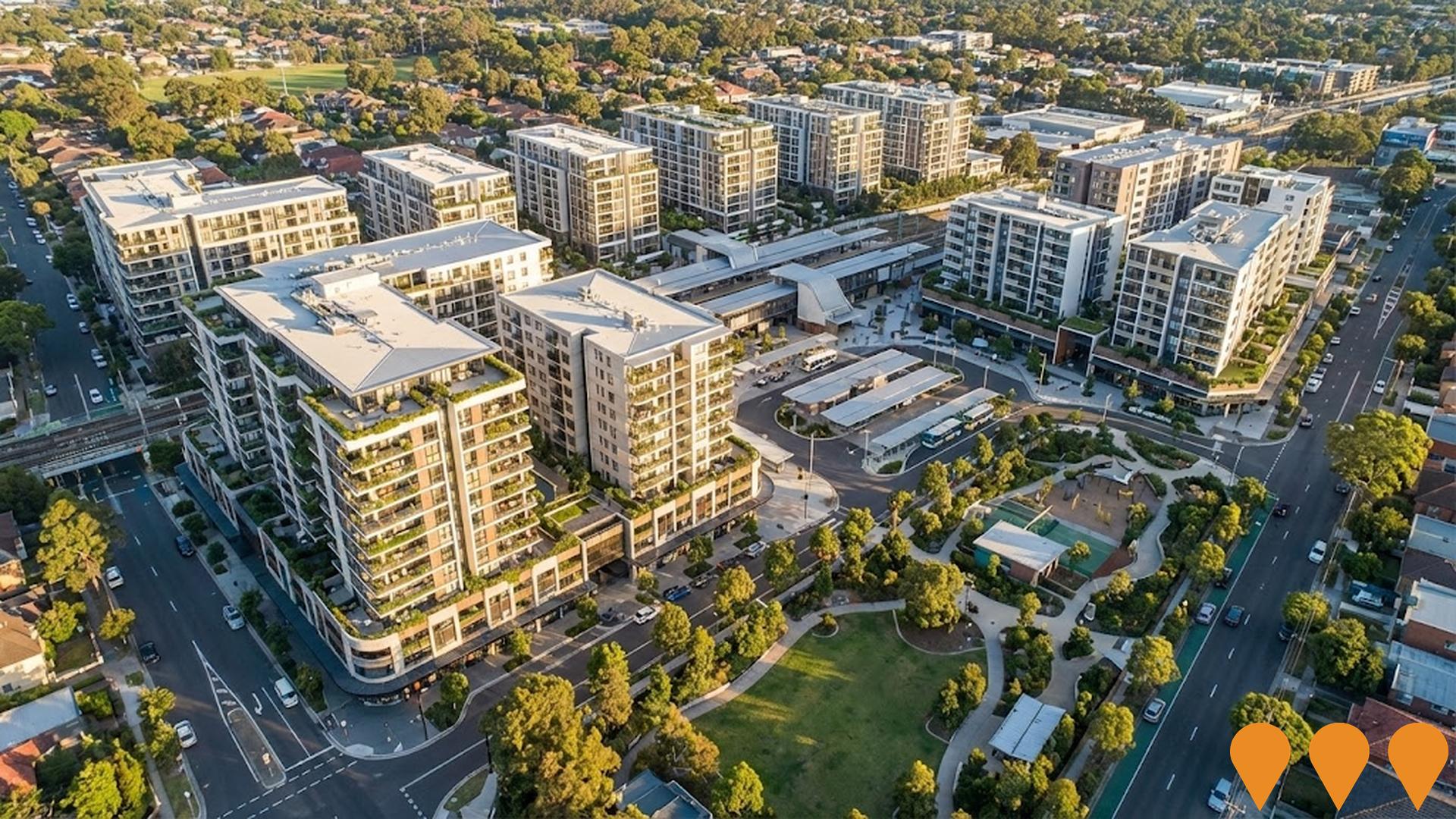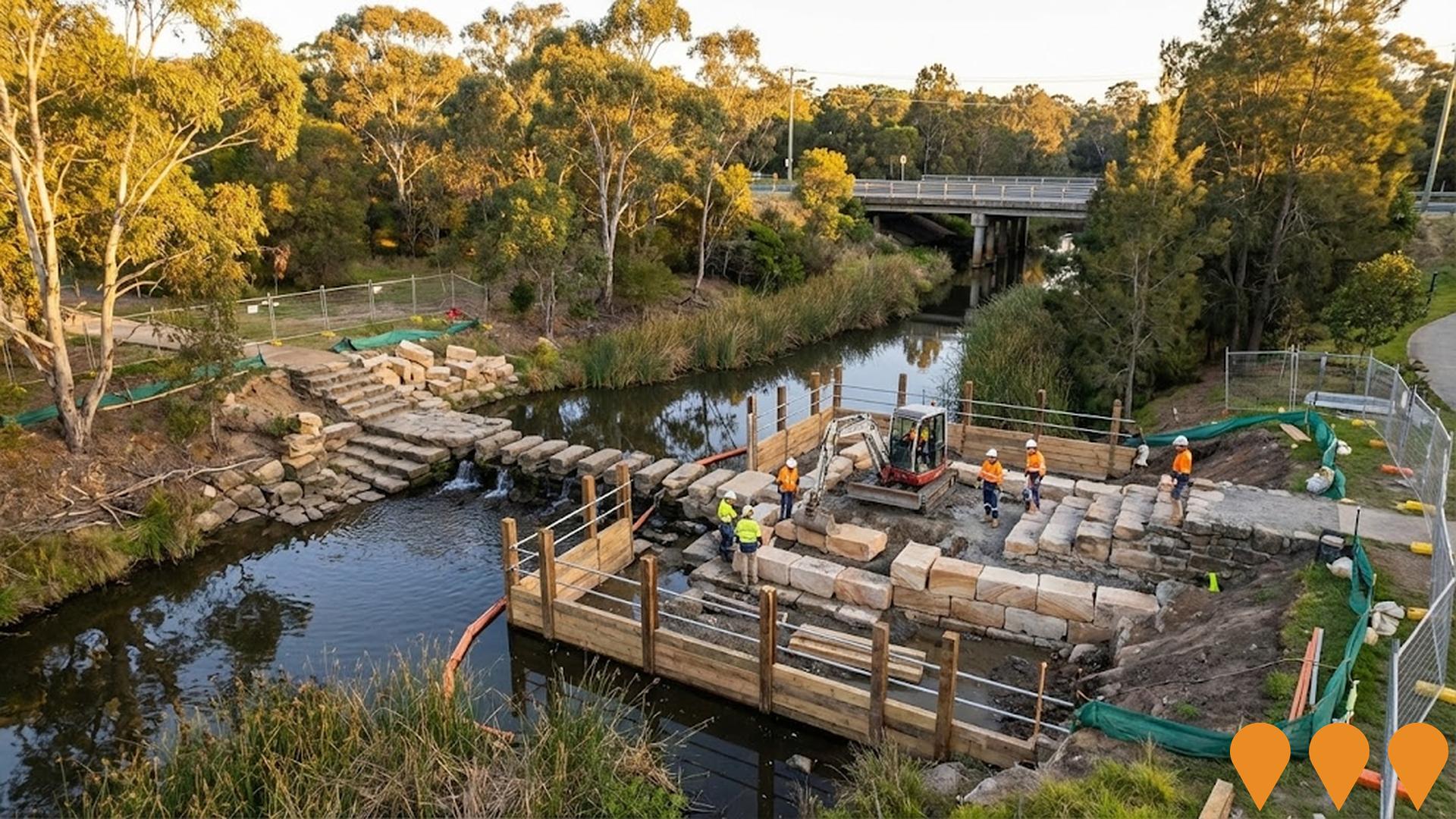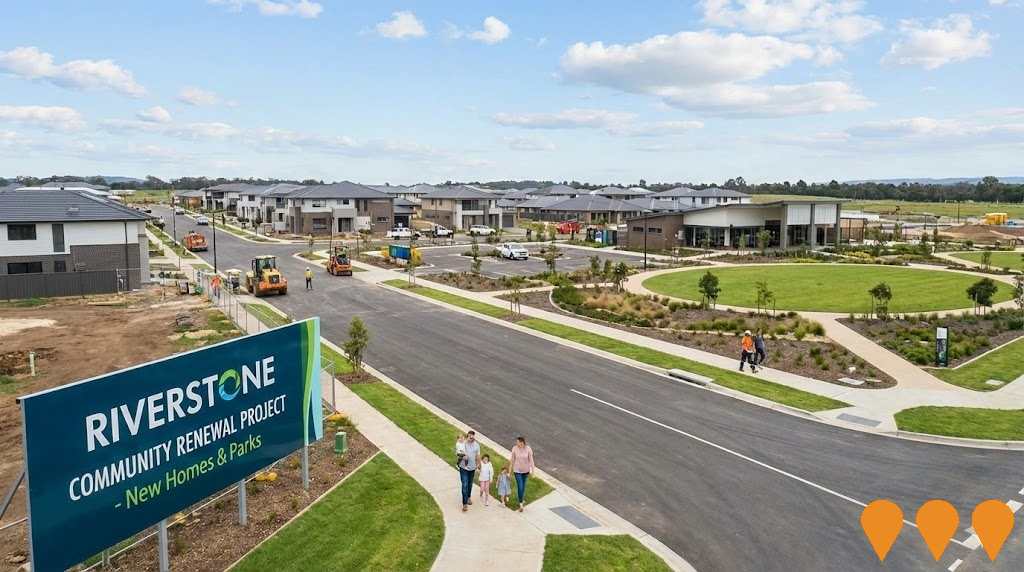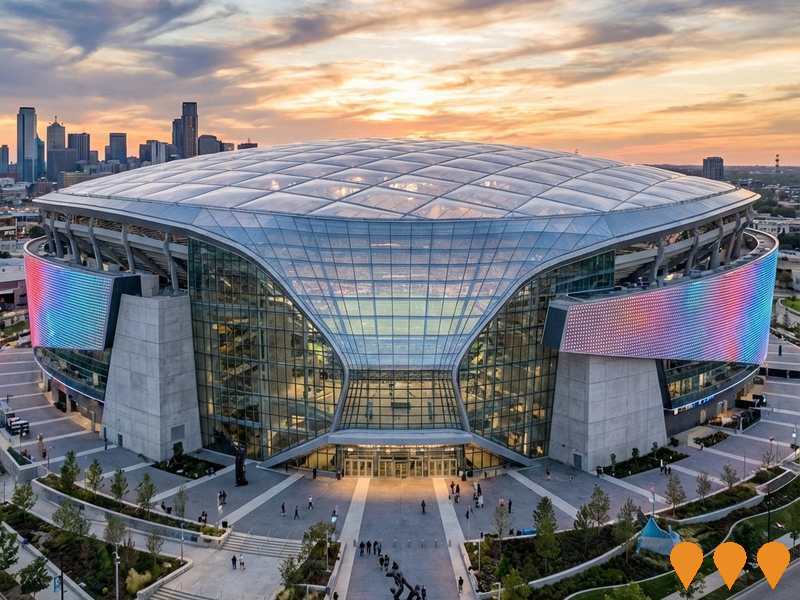Chart Color Schemes
est. as @ -- *
ABS ERP | -- people | --
2021 Census | -- people
Sales Activity
Curious about local property values? Filter the chart to assess the volume and appreciation (including resales) trends and regional comparisons, or scroll to the map below view this information at an individual property level.
Find a Recent Sale
Sales Detail
Population
Population growth drivers in Greenacre - North are strong compared to national averages based on AreaSearch's ranking of recent, and medium to long-term trends
Greenacre - North's population was approximately 15,081 as of August 2025. This figure represents an increase of 444 people, a 3.0% rise from the 2021 Census count of 14,637 individuals. The growth is inferred from the estimated resident population of 15,229 in June 2024 and address validation since the Census date. This results in a population density ratio of 3,696 persons per square kilometer, placing Greenacre - North in the upper quartile compared to other locations assessed by AreaSearch. The area's growth rate of 3.0% since the census is within 1.0 percentage point of the SA3 area's growth rate of 4.0%, indicating strong growth fundamentals. Overseas migration contributed approximately 64.9% of overall population gains in recent periods.
AreaSearch uses ABS/Geoscience Australia projections for each SA2 area, released in 2024 with a base year of 2022. For areas not covered by this data, AreaSearch employs NSW State Government's SA2 level projections released in 2022 using a base year of 2021. Growth rates by age group from these aggregations are applied to all areas for the years 2032 to 2041. Future population dynamics anticipate an increase just below the median of national areas, with Greenacre - North expected to expand by 1,550 persons to reach a total population of approximately 16,631 by 2041, marking an 11.2% increase over the 17-year period.
Frequently Asked Questions - Population
Development
Residential development activity is slightly higher than average within Greenacre - North when compared nationally
Greenacre - North has recorded approximately 66 residential properties granted approval annually. Over the past five financial years, from FY21 to FY25, around 331 homes were approved, with a further 6 approved so far in FY26. On average, over these years, about 1.4 new residents per year have been associated with each dwelling constructed. However, this figure has increased to 5 people per dwelling over the past two financial years, indicating growing demand and tightening supply.
The average construction value of development projects is $505,000. This financial year alone, $8.9 million in commercial approvals have been registered, reflecting the area's predominantly residential nature. Compared to Greater Sydney, Greenacre - North has about three-quarters the rate of new dwelling approvals per person and ranks among the 52nd percentile nationally for areas assessed. New development consists of approximately 43.0% detached houses and 57.0% medium and high-density housing, marking a significant shift from the current housing pattern of 60.0% houses. This trend suggests diminishing developable land availability and responds to evolving lifestyle preferences and housing affordability needs.
The location currently has around 317 people per dwelling approval, indicating a low density market. By 2041, Greenacre - North is projected to grow by approximately 1,690 residents. Based on current development patterns, new housing supply should readily meet demand, offering favourable conditions for buyers and potentially facilitating further population growth beyond current projections.
Frequently Asked Questions - Development
Infrastructure
Greenacre - North has very high levels of nearby infrastructure activity, ranking in the top 10% nationally
Changes to local infrastructure significantly influence an area's performance. AreaSearch has identified 16 projects likely impacting the area. Notable projects include Kevin Hill Roberts Park Community Hub, Allum Park New Sports Amenities Building, Palms Hotel Redevelopment (Palms Village), and Chullora Marketplace Redevelopment. The following list details those most relevant.
Professional plan users can use the search below to filter and access additional projects.
INFRASTRUCTURE SEARCH
 Denotes AI-based impression for illustrative purposes only, not to be taken as definitive under any circumstances. Please follow links and conduct other investigations from the project's source for actual imagery. Developers and project owners wishing us to use original imagery please Contact Us and we will do so.
Denotes AI-based impression for illustrative purposes only, not to be taken as definitive under any circumstances. Please follow links and conduct other investigations from the project's source for actual imagery. Developers and project owners wishing us to use original imagery please Contact Us and we will do so.
Frequently Asked Questions - Infrastructure
Sydney Metro West
Sydney Metro West is a new 24-kilometre underground railway connecting Greater Parramatta to the Sydney CBD. The core tunnelling section from The Bays to Sydney Olympic Park is under construction, with trains expected to operate from 2034. A separate City section (Hunter Street to Pyrmont) is in planning with an Environmental Impact Statement on public exhibition in 2025. No confirmed extension to Zetland or Green Square currently exists as part of the funded project.

Bankstown CBD Transformation
The comprehensive transformation of the Bankstown CBD is underway. Key components include the Bankstown CBD Upgrade (in construction) and the adoption of the Bankstown City Centre Master Plan (Planning Proposal submitted for Gateway Determination). The Master Plan guides streetscape improvements, new mixed-use developments, enhanced public spaces, and transport connectivity to create a vibrant, walkable city center, celebrating cultural diversity and supporting future growth. Recent completed projects under this umbrella include a $27 million stormwater upgrade, Paul Keating Park Play Space, and The Appian Way Pedestrian Mall transformation. The overall vision is a long-term, multi-developer initiative for Bankstown to become a leading health, education, and jobs hub.

Lakemba Transport Oriented Development (TOD) Masterplan
Canterbury-Bankstown Council's masterplan for the Lakemba Transport Oriented Development (TOD) precinct, which aims to create capacity for over 9,000 new homes within 400m of Lakemba station by implementing an alternative, place-based approach to the NSW Government's TOD Program. The plan features mixed-use development with residential, retail, and community facilities, focusing on increased density near public transport while respecting local character and cultural diversity, and includes enhanced public domain and community infrastructure. The Council's alternative scheme, including Recommended Planning Provisions and supporting studies, was submitted to the NSW Department of Planning, Housing and Infrastructure (DPHI) in late 2024 and is currently under assessment. The planning controls for the precinct are expected to be finalised in early 2025.

Salt Pan Creek Channel Repairs
Structural repairs and bank stabilization along Salt Pan Creek within the Cooks River catchment, affecting parts of Greenacre, Punchbowl, Belfield and nearby suburbs. Scope includes flood mitigation, stormwater channel rehabilitation, erosion control and environmental restoration works to improve waterway health and reduce flood risk.

Belfield Small Village Master Plan
Canterbury-Bankstown Council's draft master plan for the Belfield Small Village centre, guiding future change and development. It outlines desired changes to building heights, design, land use zones, new open space, public domain improvements, and new housing opportunities, while preserving the area's unique character. The draft plan was open for community consultation (Stage 2) until December 2025.

Kevin Hill Roberts Park Community Hub
New 1,000 square metre multi-purpose community facility including a 300 square metre Library and Knowledge Centre, 550 square metre multipurpose community centre with hall and meeting rooms, and outdoor spaces including terrace and reading room connecting to existing park facilities.

Palms Hotel Redevelopment (Palms Village)
Court-approved mixed-use redevelopment of The Palms site delivering a 56-room hotel, relocated pub, 92 apartments across multiple buildings (37 in a five-storey mixed-use building and 55 in three 3-storey residential flat buildings), 1,459 sqm of ground-floor commercial space and basement parking for 323 vehicles, to be delivered in three stages. The existing pub will be temporarily relocated before taking up its new permanent home in a new three-storey structure beneath the hotel.

Greenacre Community Place Precinct Framework
Planning framework adopted by Council in June 2024 to guide future development of the Greenacre Community Place precinct. The framework identifies opportunities for improved recreation and open spaces, and a potential future indoor recreation facility on the site of the former Greenacre Leisure & Aquatic Centre. The framework complements the new Roberts Park Community Hub and supports the function of Greenacre Town Centre.

Employment
Employment conditions in Greenacre - North face significant challenges, ranking among the bottom 10% of areas assessed nationally
Greenacre - North has a skilled workforce with diverse sector representation. Its unemployment rate was 10.0% in the past year, with an estimated employment growth of 1.6%.
As of June 2025, there were 5,911 residents employed while the unemployment rate stood at 5.8%, which is higher than Greater Sydney's rate of 4.2%. Workforce participation was significantly lower in Greenacre - North, at 42.4% compared to Greater Sydney's 60.0%. The key industries employing residents were health care & social assistance, retail trade, and construction. The area showed strong specialization in transport, postal & warehousing with an employment share of 1.6 times the regional level.
Conversely, professional & technical services had lower representation at 7.7% compared to the regional average of 11.5%. Employment opportunities locally appeared limited as indicated by the Census working population vs resident population count. Between June 2024 and June 2025, employment levels increased by 1.6%, while labour force grew by 2.5%, causing the unemployment rate to rise by 0.8 percentage points. In contrast, Greater Sydney experienced employment growth of 2.6% and labour force growth of 2.9%, with a smaller rise in unemployment rate of 0.3 percentage points. Jobs and Skills Australia's national employment forecasts from May 2025 suggest that over five years, employment is expected to expand by 6.6%, and over ten years by 13.7%. Applying these projections to Greenacre - North's employment mix suggests local growth of approximately 6.5% over five years and 13.4% over ten years.
Frequently Asked Questions - Employment
Income
Income figures position the area below 75% of locations analysed nationally by AreaSearch
Greenacre - North had a median taxpayer income of $39,418 and an average income of $53,524 in the 2022 financial year, according to postcode level ATO data aggregated by AreaSearch. This is lower than national averages, contrasting with Greater Sydney's median income of $56,994 and average income of $80,856. By September 2025, estimates suggest the median income would be approximately $44,389 and the average income around $60,273, based on Wage Price Index growth of 12.61% since 2022. Census 2021 data shows individual incomes at the 3rd percentile were $496 weekly, while household incomes were at the 31st percentile. Income distribution indicates that 29.2% of locals (4,403 people) fell into the $1,500 - 2,999 income category, similar to the broader area where 30.9% occupied this range. Housing affordability pressures are severe in Greenacre - North, with only 77.5% of income remaining, ranking at the 22nd percentile.
Frequently Asked Questions - Income
Housing
Greenacre - North displays a diverse mix of dwelling types, with ownership patterns similar to the broader region
In Greenacre - North, as per the latest Census evaluation, 59.7% of dwellings were houses, with the remaining 40.3% comprising semi-detached homes, apartments, and other types. This compares to Sydney's metropolitan area where 61.5% of dwellings are houses and 38.4% are other types. Home ownership in Greenacre - North stood at 29.8%, similar to the Sydney metro level, with mortgaged dwellings accounting for 34.3% and rented dwellings making up 35.9%. The median monthly mortgage repayment in the area was $2,253, higher than the Sydney metro average of $2,240. Weekly rent median was recorded at $400, compared to Sydney's $425. Nationally, Greenacre - North's mortgage repayments exceeded the Australian average of $1,863, while rents were higher than the national figure of $375.
Frequently Asked Questions - Housing
Household Composition
Greenacre - North features high concentrations of family households, with a higher-than-average median household size
Family households comprise 77.4% of all households, including 45.8% couples with children, 14.9% couples without children, and 15.6% single parent families. Non-family households account for 22.6%, with lone person households at 20.6% and group households comprising 1.9%. The median household size is 3.3 people, larger than the Greater Sydney average of 3.1.
Frequently Asked Questions - Households
Local Schools & Education
Educational attainment in Greenacre - North aligns closely with national averages, showing typical qualification patterns and performance metrics
The area's university qualification rate is 25.8%, considerably lower than Greater Sydney's average of 38.0%. Bachelor degrees are the most common at 18.2%, followed by postgraduate qualifications (6.5%) and graduate diplomas (1.1%). Vocational credentials are prevalent, with 25.8% of residents aged 15+ holding them - advanced diplomas at 9.7% and certificates at 16.1%. Educational participation is high, with 37.1% of residents currently enrolled in formal education: 11.9% in primary, 11.2% in secondary, and 7.3% in tertiary education.
Greenacre - North has 4 schools with a combined enrollment of 4,256 students, operating under typical Australian school conditions (ICSEA: 1039) with balanced educational opportunities. The area's 2 primary and 2 K-12 schools function as an education hub, offering 28.2 school places per 100 residents - significantly higher than the regional average of 16.8 - attracting students from surrounding communities.
Frequently Asked Questions - Education
Schools Detail
Nearby Services & Amenities
Transport
Transport servicing is good compared to other areas nationally based on assessment of service frequency, route connectivity and accessibility
Greenacre - North has 118 active public transport stops operating within its boundaries. These stops are served by a mix of buses along 26 individual routes, collectively offering 2,100 weekly passenger trips. Transport accessibility is rated excellent, with residents typically located 129 meters from the nearest stop.
Service frequency averages 300 trips per day across all routes, equating to approximately 17 weekly trips per stop.
Frequently Asked Questions - Transport
Transport Stops Detail
Health
The level of general health in Greenacre - North is notably higher than the national average with prevalence of common health conditions low among the general population though higher than the nation's average across older, at risk cohorts
Greenacre - North shows superior health outcomes with lower prevalence of common conditions among its general population compared to national averages. However, higher rates are seen in older, at-risk cohorts.
Private health cover stands at approximately 47% (~7,088 people), below the national average of 55.3%. Diabetes and arthritis are the most prevalent conditions, affecting 6.3% and 6.1% respectively. 75.1% of residents report no medical ailments, slightly lower than Greater Sydney's 75.8%. The area has 15.8% seniors (2,387 people), with health outcomes requiring more attention compared to the broader population.
Frequently Asked Questions - Health
Cultural Diversity
Greenacre - North is among the most culturally diverse areas in the country based on AreaSearch assessment of a range of language and cultural background related metrics
Greenacre-North is among the most culturally diverse areas in Australia, with 43.5% of its population born overseas and 68.9% speaking a language other than English at home. The dominant religion in Greenacre-North is Islam, comprising 48.0% of the population, which is higher than the Greater Sydney average of 27.9%. Regarding ancestry, the top three groups in Greenacre-North are Lebanese (27.6%), Other (24.8%), and Australian (12.7%).
Notably, Korean (2.6%) and Vietnamese (2.2%) populations are overrepresented compared to regional averages of 0.7% and 8.5%, respectively. Additionally, the Greek population is slightly higher at 2.6%.
Frequently Asked Questions - Diversity
Age
Greenacre - North hosts a young demographic, positioning it in the bottom quartile nationwide
Greenacre - North's median age is 34 years, which is lower than Greater Sydney's average of 37 years and considerably younger than Australia's median age of 38 years. Compared to Greater Sydney, Greenacre - North has a higher proportion of residents aged 5-14 (15.1%) but fewer residents aged 25-34 (12.5%). Between the censuses of 2021 and 2026, the population aged 15 to 24 increased from 14.7% to 16.0%, while the proportion of those aged 5 to 14 decreased from 15.7% to 15.1%. By 2041, significant demographic changes are projected for Greenacre - North. The 75 to 84 age group is expected to grow by 80%, adding 590 residents and reaching a total of 1,328. Residents aged 65 and above will drive 66% of population growth, indicating demographic aging trends. Conversely, population declines are projected for the 5 to 14 age group and the 0 to 4 age group.


